Lookout
+98
Cooper
Dalton
Ravenson
Accer
Spectrum
RazzorSharp))
Looper
Geoman
Colter
Scout
Kingway
Vmaxocalz
Oliver
Tracker
Mercury
Fascinator
Viper
Lockey
Zoneforce
Firefox
Hammercore
Spartan
Jumper
Rocko
Luxray
Whiskey
Mountaineer
Monsfool
Lux4795
Apollo
Scorpion
Leopard
Slider
Riverway
Powergunner
Proctor
Logan
Rockarm
Ringo
Covert
Lightning
Joker
Braven
Replica
Stargunner
Vexmax
Alpha
Firestrike
Kizzer
Diesel
Echostar
Vizzer
Unicorn
Forcell
Victor
RunningLight
Exodus
TRZ.55
Wolfman
Spider
Cool~Way
Charlie
TangoZulu77
SniperGod
Phantom
Terminator
Lionfield
Zodiac
Seawolf
Lincoln
RevForce
Tazzer
Lonestar
Armoured
Jackal
OutlawSoldier
Navigator
Wolverine
Zapper
Phrampton
Hunter
Sandman
Ironman
Enforcer
Masefield
Mojave
Stayner
Marshall
Thunder
Jeremiah
Starman
Caliber
Falcon
Warrior
Gridlock
Stanleyz
Jackson
Cypher
102 posters
Page 3 of 23
Page 3 of 23 •  1, 2, 3, 4 ... 13 ... 23
1, 2, 3, 4 ... 13 ... 23 
 Re: Lookout
Re: Lookout
HMCS Calgary showcases the Royal Canadian Navy
By Lookout on Sep 03, 2019
By Lookout on Sep 03, 2019
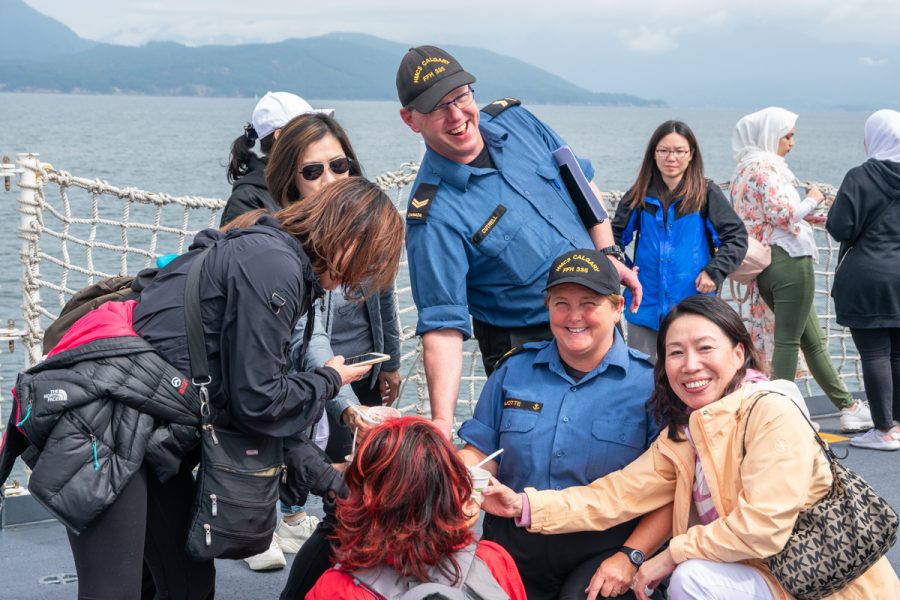
SLt M.X. Déry, MARPAC PA Office ~
High speed turns, fighting fires, the Royal Canadian Navy mascot Sonar, a Cyclone buzzing past and ice cream, could you ask for more?
HMCS Calgary pulled all the stops last weekend to show girls and women from Achieve Anything Foundation’s Operation This is You, and a host of VIPs from the City of Vancouver, everything that the navy has to offer.
“Sails like this are about awareness, about why a navy is important, about why Canada is a maritime nation, but most importantly about why the sailors you meet today love their job, love their country, love what they do,” said Cdr Jonathan Kouwenberg, Commanding Officer of Calgary.
The ship departed North Vancouver early Saturday morning and headed for Howe Sound as the nearly 200 guests were split into smaller groups to explore all aspects of life at sea. On the flight deck, guests donned bunker gear and watched mock firefighting hot door procedures.
In the hangar, members of the ship’s Naval Boarding Party fielded questions in full gear, while other groups were shown the ship’s multiple weapons systems on the upper decks, or the engineering compartments below deck.
Sonar made a quick appearance to dispense high fives to children and help in some of the tour displays.
After lunch and some ice cream, guests were treated to a Cyclone helicopter from 443 Maritime Helicopter Squadron demonstrating its aerial prowess, followed by Calgary performing a man overboard exercise to highlight the warship’s maneuverability.
Throughout it all, the ship’s program was narrated by one voice, that of Lt(N) Samantha Bayne, Calgary’s Underwater Warfare Officer.
“It was a great experience being the voice of Calgary,” said Lt(N) Bayne. “Getting to showcase what we do in the navy, especially for the ‘This is you’ foundation, that really hit home, as one of the senior female leaders on the ship.”
Lt(N) Bayne joined the navy through her high school sports program; she spoke to coaches at the Royal Military College when her high school played in a basketball tournament at the college. Her athleticism has continued into her career, playing on numerous Canadian Armed Forces teams in basketball and volleyball. This and her senior role in the operations room made her the natural choice to MC the proceedings as a role model to girls and young women.
“It was an opportunity to expose a lot of women to different kinds of jobs and roles they can hold on a ship,” said Lt(N) Bayne. “Roles they might fill in the future.”
For Cdr Kouwenberg, the day sail was about creating connections between sailors and the public.
“It’s funny; you join the navy thinking that you’ll get to drive ships, shoot guns and travel the world, but what it ends up coming back to is people and relationships,” he said to the crowd before they departed Calgary. “Today was all about building those relationships.”

Cypher- Registered User
- Posts : 336
Join date : 2017-10-13
 Re: Lookout
Re: Lookout
DND historian seeking veterans from Operation Snowgoose
By Lookout on Sep 16, 2019
By Lookout on Sep 16, 2019
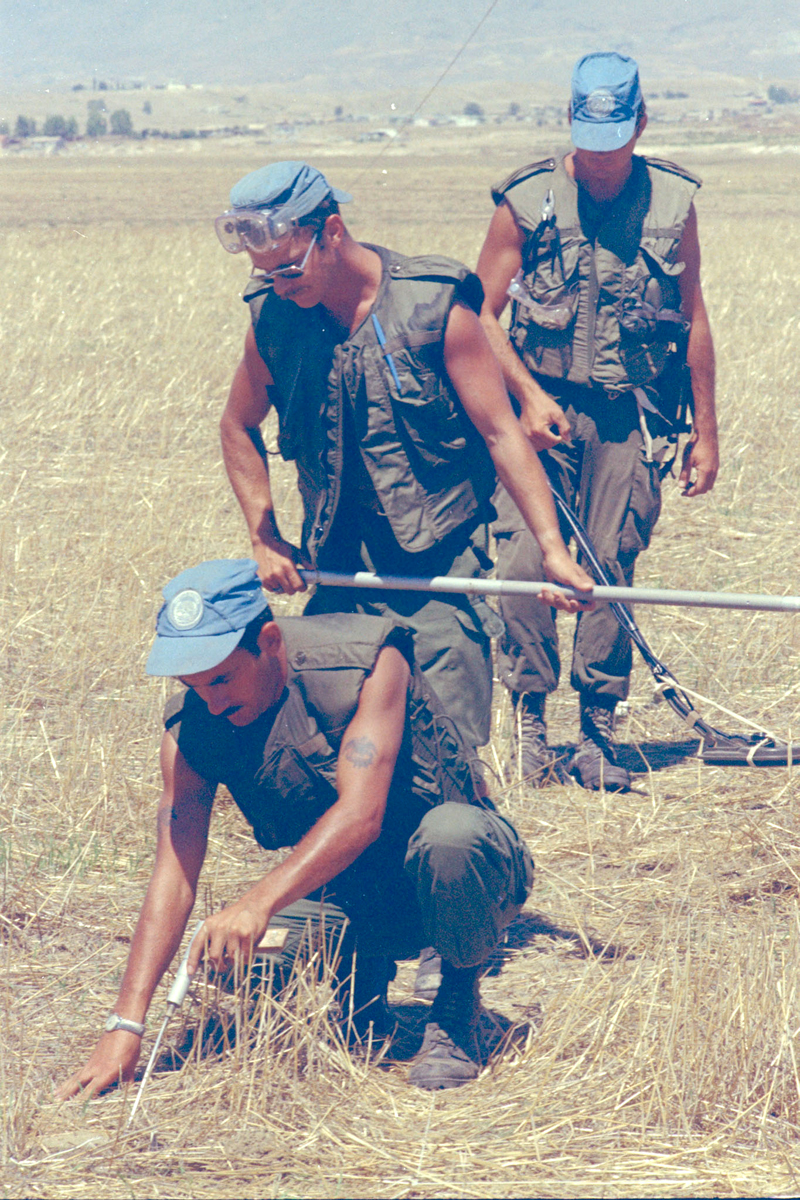
United Nations troops search for mines in Cyprus.
Peter Mallett, Staff Writer ~
A Department of National Defence historian from Ottawa will be visiting the base next month to interview veterans that served in Canadian Armed Forces peacekeeping operations in Cyprus.
John Macfarlane, from Directorate of History and Heritage (DHH), is compiling research for a book that will include first-hand accounts by veterans on Operation Snowgoose, Canada’s contribution to United Nations peacekeeping operations in Cyprus between 1964 and 1993. MacFarlane will conduct interviews at the CFB Esquimalt Naval and Military Museum Oct. 2 and 3.
Ahead of his visit to the base, he is looking for veterans of all ranks and trades from Victoria’s military community for their stories on Operation Snowgoose and their role in the mission. The focus of the research is the soldiering aspects and is specifically logistics based.
“We are not focusing on policy, politics and external affairs, but are looking specifically at operations, what Canadian soldiers were doing and how they adapted and responded to the situation,” said MacFarlane.
DHH has a mandate within DND to preserve and communicate Canada’s military history and foster pride in military heritage. The intention, says MacFarlane, is to educate Canadian Armed Forces members and the Canadian public while shaping history.
Veterans of Op Snowgoose can write about their experiences, agree to a formal interview, or simply be accessible by email or phone for the occasional question to help clarify certain aspects of the operation.
A key area of MacFarlane’s research involves a firefight between Turkish and Greek forces in the summer of 1974 following a Turkish invasion. He is looking for first-hand accounts of how Canadian peacekeepers reacted to the firefight.
“They had sent Canadian peacekeepers to keep the peace, but if national defence was involved in a war that was a whole new ballgame,” said MacFarlane.
The DHH’s research on Cyprus began 18 years ago under the guidance of Maj (Retired) Jean Morin who oversaw the research project for 15 years. MacFarlane began his involvement three years ago and has interviewed approximately 40 subjects in both Ontario and the Maritimes, but this will be his first visit to Victoria. He says the sizable military community and number of veterans living here make it one of the prime locations in Canada to conduct his research.
The completed publication will include a narrative, one-on-one interviews, photographs, maps and other graphics, and is slated for completion in 2024.
To schedule an interview with MacFarlane, veterans are encouraged to contact him at his email
john.macfarlane@forces.gc.ca For more information about the DHH visit its webpage:
www.cmp-cpm.forces.gc.ca/dhh-dhp/index-eng.asp

Ironman- Registered User
- Posts : 338
Join date : 2018-02-25
 Re: Lookout
Re: Lookout
In Photos: Military help Dorian cleanup
By Lookout on Sep 16, 2019
By Lookout on Sep 16, 2019
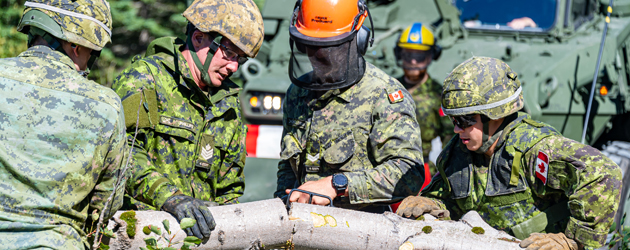
Last week, the Canadian Armed Forces assisted Canadians in their time of need on Operation Lentus following Hurricane Dorian.

Navigator- Advocate Coordinator
- Posts : 279
Join date : 2018-02-02
 Re: Lookout
Re: Lookout
Military tests anti-submarine warfare
By Lookout on Sep 17, 2019
By Lookout on Sep 17, 2019
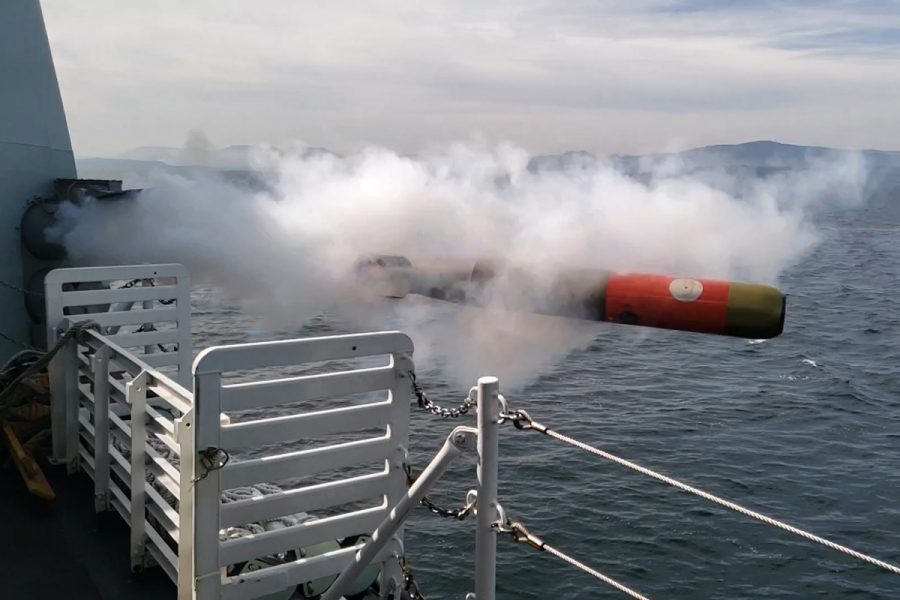
SLt Zachary Jackson, HMCS Calgary ~
Last month, HMCS Calgary along with HMCS Whitehorse, Canadian Forces Maritime Warfare Centre, 443 Maritime Helicopter Squadron, and 19 Wing Comox took part in Optest Stargazer. The goal of the two-week exercise was to test anti-submarine warfare equipment and doctrine in order to improve how warships conduct anti-submarine operations.
One of the highlights of the exercise was a series of Mk 46 Torpedo firings. The Mk 46 Lightweight Torpedo is the primary weapon used by the Royal Canadian Navy and the Royal Canadian Air Force against submarine threats. The rounds were Exercise Torpedoes (EXTORPS). This meant the torpedo was able to be fired, move through the water, tracked, and finally target a submarine without having any explosive payload embarked.
Using an EXTORP allows the military to employ the weapon in a realistic way and collect relevant data without any undue costs or risk. Personnel can then analyze the data and see why the weapon was either successful or unsuccessful. This is crucial in determining how to improve both the way the military fights and the weapons used.
Calgary’s Under Water Warfare Officer, Lt (N) Samantha Bayne commented on the importance of this exercise. “Calgary’s participation in Optest Stargazer enabled the RCN to enhance underwater warfare tactics. Calgary contributed to the exercise’s effectiveness in providing a focused opportunity to demonstrate potential new equipment and procedures.”
The exercise was the culmination of weeks of work by both the Operations Department and the Combat Systems Engineering Department.

OutlawSoldier- CF Coordinator
- Posts : 221
Join date : 2017-12-16
 Re: Lookout
Re: Lookout
New CADPAT design being tested
By Lookout on Sep 20, 2019
By Lookout on Sep 20, 2019
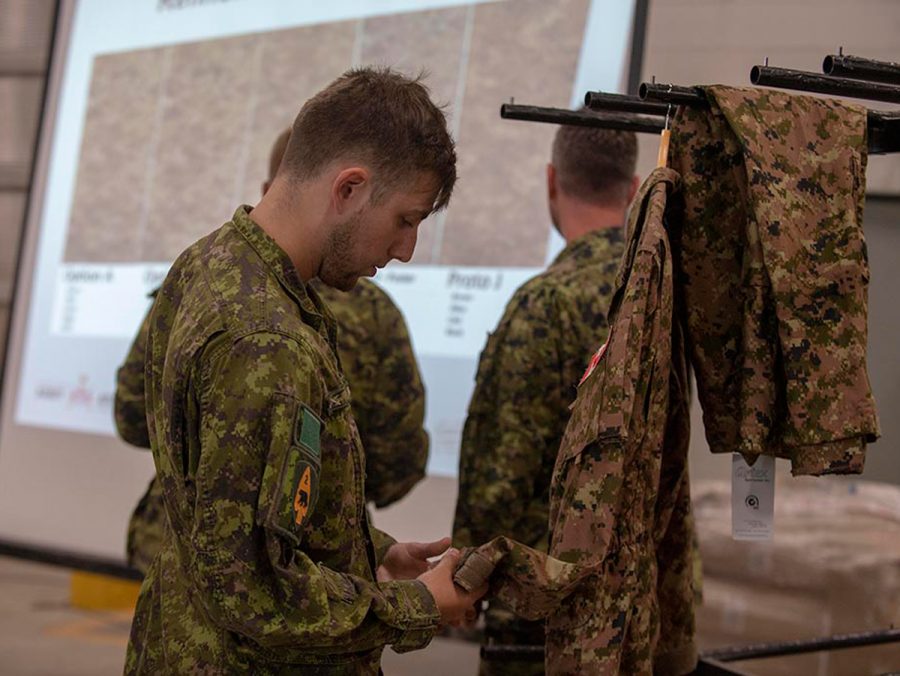
Eric De Lafontaine, Manager Soldier Operational Clothing and Equipment Modernization, DSSPM ~
More than 600 soldiers at 4 Canadian Division Support Base Petawawa will test a new Canadian Disruptive Pattern (CADPAT) to help select replacement camouflage for the current iconic woodland and arid CADPAT patterns.
The original distinctive CADPAT, revolutionary for its time, was initially developed in 1997. It is most closely associated with the Canadian Army, but it is also worn by airforce and naval personnel when they work on land.
Canadian Special Operations Forces personnel wear another pattern, MultiCam, which is not being replaced.
Since CADPAT was issued, there have been several advances made in camouflage research, specifically protection from detection by infra-red and other night vision systems.
Starting at the end of September, 3rd Battalion, Royal Canadian Regiment will begin wearing coats and trousers, shell fragmentation protective body armor, bush caps, helmet covers and rank patches in the “Prototype J” mid-spectrum pattern.
This new four-colour pattern falls in the middle of the camouflage spectrum, not overly emphasizing brown or green tones.
While there have been over a dozen patterns tested, this is the first pattern to be taken out of a lab and tested using real soldiers who are undergoing rigorous training for overseas operations. There will likely be adjustments made to the pattern resulting from this trial.
The trial will last until July 2020. During this time, the Human Factors Support Cell from the Soldier Systems Directorate within Director General Land Equipment Program Management will seek user feedback about the “Prototype J” pattern by conducting large-scale questionnaires.
The team will also conduct data collection, focus groups, and 3D body scanning to define how the current operational uniform and personal equipment can be improved.
This study will also include seeking out soldiers of smaller stature, including but not exclusively women, to ensure that the next generation of clothing and equipment fit the widest variety of soldiers possible.
The Soldier Operational Clothing and Equipment Modernization project, led by the Canadian Army Director of Land Requirements, in cooperation with Assistant Deputy Minister (Materiel) and Defence Research and Development Canada, has been working for over two years on harnessing technological advances to improve the functionality of Canadian Armed Forces operational uniforms and equipment.
The goal is operational clothing and equipment that protect and fit better while lightening the load carried by soldiers.
Transitioning to a single pattern from the current temperate woodland (green), and arid (tan) will also create efficiencies in terms of logistics.
With the final decision expected no later than 2022 and a full roll out 2027, the interim years will see mixed uniforms and equipment as items in the new pattern are gradually acquired and put into service.

Stanleyz- Registered User
- Posts : 333
Join date : 2018-02-04
 Re: Lookout
Re: Lookout
Naval Cadets enjoy incredible USN exchange
By Lookout on Sep 27, 2019
By Lookout on Sep 27, 2019
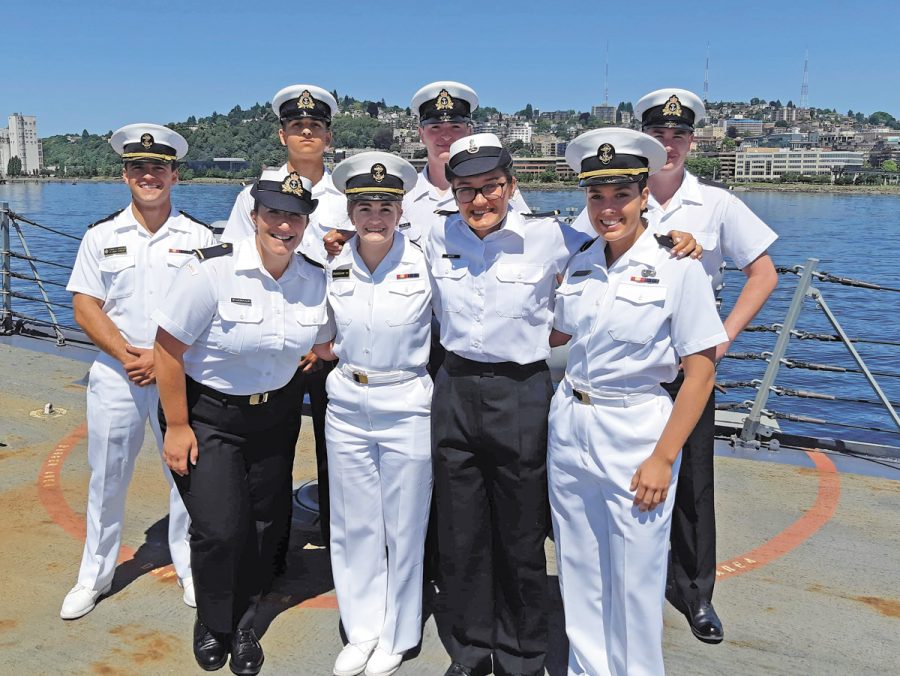
Peter Mallett, Staff Writer ~
A group of Naval Cadets gave glowing reviews about their recent summer job placements aboard the United States Navy (USN) vessel USS Spruance.
The six junior sailors are enrolled in the Canadian Armed Forces Regular Officer Training Program (ROTP). They recently wrapped up three-week job placements aboard the USN’s Arleigh Burke-class destroyer.
They embarked Spruance in Seattle and arrived at U.S. Naval Base San Diego on Aug. 27.
Their participation was part of the ROTP’s On the Job Employment (OJE) program. OJE finds work placements in the Canadian Armed Forces for 160 naval cadets throughout the summer months when they are not attending classes at Royal Military College in Saint-Jean, Que., Kingston, Ont. or Canadian universities.
Lieutenant (Navy) Tony Greenwood, Basic Training List (BTL) Manager for Junior Naval Warfare Officers at the Naval Personnel and Training Group (NPTG), helped organize this year’s exchange.
Lt(N) Greenwood, a former graduate of the ROTP in 2014, says the intention of the exchange is to give cadets practical experience on a warship.
“I also had some interesting work placements during my time in ROTP, but sailing aboard a USN destroyer is an incredible assignment for these young sailors and by all reports they thoroughly enjoyed it. The idea was to give this group of cadets practical experience on a warship and it was mission accomplished.”
This year’s participants were NCdt Jonathan Anderson, NCdt Eve Baker, NCdt Farris Bakir, NCdt Timothy Baljet, NCdt Lisa Grandmaison and NCdt Alex Morneau.
Four of the cadets spent most of their time in Spruance assisting with bridge watchkeeping duties. Two other students, NCdt Baker who is studying to become a Logistics Officer, and NCdt Morneau, an engineer, were involved in their respective departments in the ship.
In his review of the placement, NCdt Baljet said he was thoroughly enthused about the opportunity to learn outside the classroom while aboard Spruance.
“This was an incredible opportunity for learning the capabilities, customs and organization of the USN,” said NCdt Baljet. “The U.S. sailors welcomed us and then assigned us to a junior officer to shadow and help them complete their watches alongside and underway. We also had ample opportunity to explore both the ship and the ports of call in Everett, Seattle, Seal Beach, and San Diego.”
OJE placements here in Esquimalt included work-study placements at Fleet Diving Unit Pacific, the Naval Tactical Operation Group’s Advanced Boarding Party, and the Canadian Forces Sailing Association.
The Regular Officer Training Program gives young Canadians an opportunity to obtain both an officer’s commission in the Canadian Armed Forces and an undergraduate degree. The aim of the ROTP is to develop selected young men and women as officers in the CAF in a variety of career occupations. Successful ROTP candidates enrol in the CAF as Officer Cadets and attend the Royal Military College of Canada or the Royal Military College of St-Jean or an approved Canadian University. For more information visit the webpage: www.rmc-cmr.ca/en/registrars-office/regular-officer-training-plan-rotp

Caliber- Registered User
- Posts : 232
Join date : 2018-02-10
 Re: Lookout
Re: Lookout
Veterans remember fallen comrade of 50 years ago
By Lookout on Oct 01, 2019
By Lookout on Oct 01, 2019
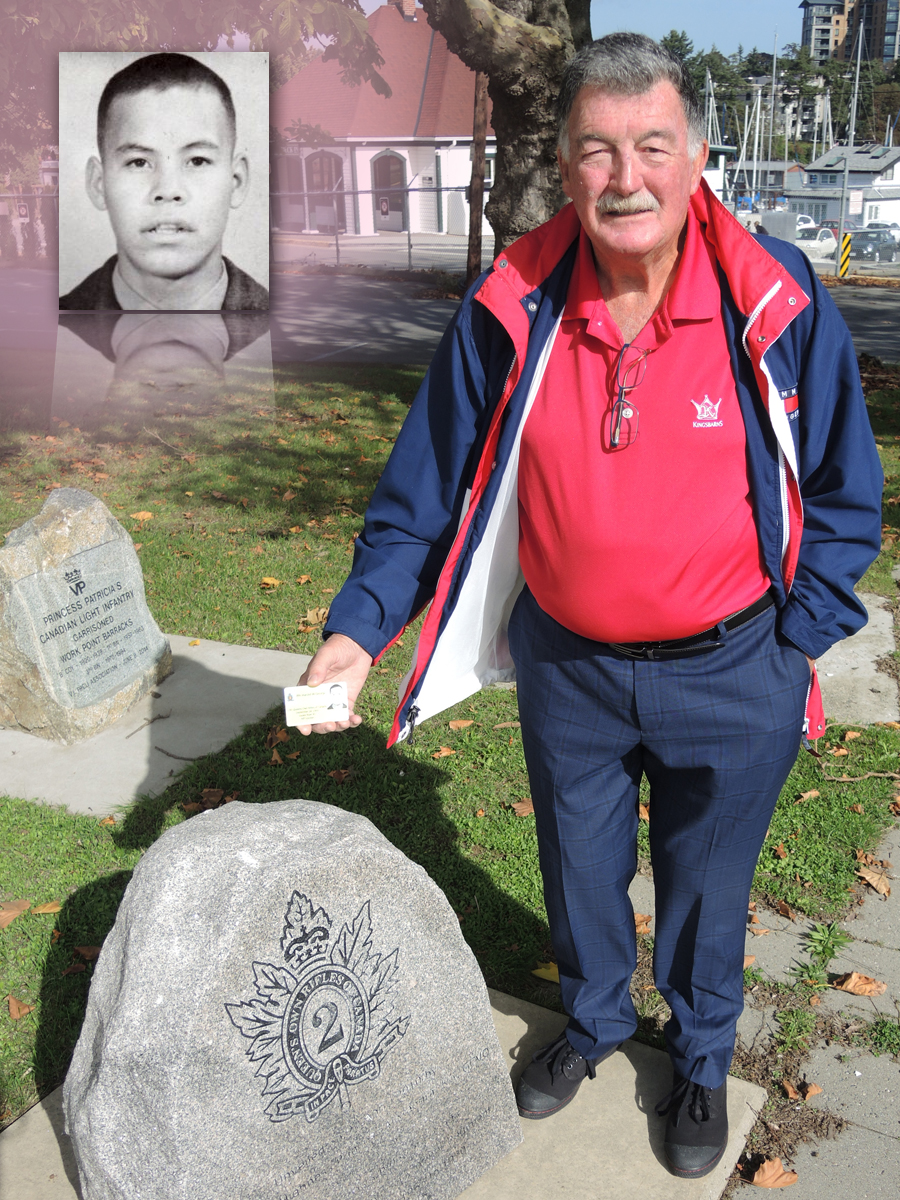
Peter Mallett, Staff Writer ~
Three former members of the Queen’s Own Rifles 1st Battalion gathered at Sooke Potholes last week to remember a fallen comrade who died in a training accident 50 years ago.
The memorial was organized by Master Corporal (Retired) Ray Weeks for his friend and platoon mate, Rifleman Harold George, who drowned in the fast-moving Sooke River during a training exercise.
Weeks, 72, travelled from his home in Gold Coast, Australia, to attend the ceremony. He was joined by two former platoon mates from ‘A Company’.
“The memorial didn’t have a sequence or a blessing or a padre. It just included members of the battalion who wanted to say goodbye to our friend,” said Weeks. “I never got a chance to say goodbye to Harold back then because I was injured in the training exercise and in the hospital for weeks. The whole incident still weighs heavily in my mind, so I decided to do something about it.”
On Sept. 24, 1969, George was 19 when the 12-foot rubber assault boat he was riding in capsized in the rapids, leading to his drowning death.
The soldiers had travelled from their unit’s headquarters at the Work Point Barracks for a three-day Watermanship Training Exercise on the Sooke River above the potholes, located 40 kilometres west of Victoria. George was among 40 men riding in four rubber boats when the accident occurred.
Weeks was one of two soldiers who were injured in the accident. He suffered extensive bruising, a fractured skull and concussion and damaged inner ear.
George’s body was recovered the next morning after an extensive overnight search by members of the Royal Canadian Mounted Police and his battalion.
A funeral service with the Battalion Burial Party was conducted at Forrest Lawn Memorial Park the following week but Weeks was still recovering from his injuries in hospital and was unable to attend.
The two men were teammates on the Queen’s Own Rifle soccer team and like many soldiers had what Weeks and other veterans describe as an “unbreakable bond.”
“He was a quiet type of guy who always seemed to keep to himself and did his job as a soldier extremely well,” said Weeks. “The Queen’s Rifles were tight and its members did everything together in those days. That’s why I thought it was so important to remember Harold.”
The ill-fated exercise
Their doomed journey began six kilometres to the north of the Sooke Potholes. At some point on the river, boats overturned in the fast-flowing current and George disappeared under the water. Most platoon mates made it to shore safely. They were all wearing lifejackets, but not helmets.
George’s death resulted from a series of miscues and mistakes according to Weeks and official accounts. A military inquest into his death was held in the months following the incident. The Victoria Daily Times reported in December 1969 that a military court of inquiry blamed the incident on a “lack of planning and forethought” by senior officers in the Queen’s Own Rifles.
Two officers of the Battalion were charged under the National Defence Act with Neglect to Prejudice of Good Order and Discipline. Both men appeared before Summary Trials and were given reprimands for their actions.
“It still sits in my mind today,” said Weeks. “When people grow older and age you start to think a lot more about things that happened in the past, so I decided to do something about it and remember Harold.”
For more on the Queen’s Own Rifles and a special web page dedicated to George visit their website: https://qormuseum.org/soldiers-of-the-queens-own/george-harold-wayne/

Navigator- Advocate Coordinator
- Posts : 279
Join date : 2018-02-02
 Re: Lookout
Re: Lookout
CTF Command, deployment reflection
By Lookout on Oct 07, 2019
By Lookout on Oct 07, 2019
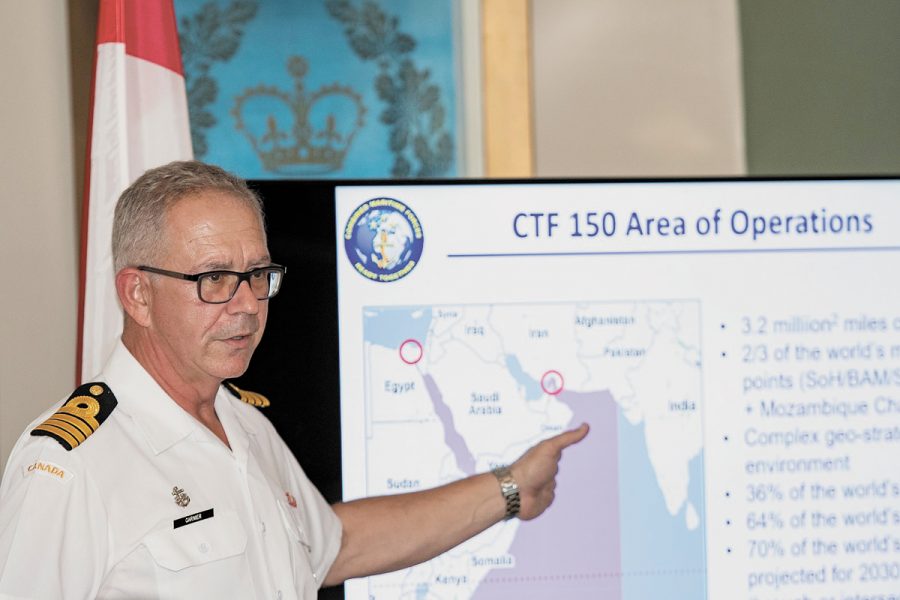
Ryan Melanson, Trident Newspaper ~
Combined Maritime Forces (CMF) is a 33-nation naval partnership that has worked to promote security and stability in the Middle East since 2002.
While the coalition has had success combating terrorism, piracy, and other wrongdoing, the working relationship between countries isn’t always simple.
The coalition is non-binding, meaning no nation can be forced to carry out operations under the CMF banner, and the variety of nations included means different ways of conducting military business and different sets of national values.
When Combined Task Force 150, one of CMF’s three task groups, came under Canadian command from December 2018 – April 2019 under the leadership of Capt(N) (now Retired) Darren Garnier, the team adopted a Canadian way of doing things. Capt(N) Garnier established a Command Chief Petty Officer position to work alongside him in Bahrain at CTF 150 HQ, emphasizing the important role of senior non-commissioned members in the Canadian Armed Forces, and he also made sure his unit’s six female officers were front and centre for tasks and meetings.
“It was something I wanted to establish; in some of the countries we visit in that part of the world, non-commissioned members and women members are sometimes not well valued by their militaries. We had a great team and part of our mandate was to empower them,” he said.
The Canadian contribution to CMF is known as Operation Artemis. Capt(N) Garnier, who recently retired from the CAF following the deployment, spoke to members of the Royal United Services Institute of Nova Scotia on Aug. 21, delivering a presentation that included results from this 12th rotation of Op Artemis, as well an overview of the difficulties that come from operating in the region.
It can be a high-stress environment, and that was made painfully clear during Canada’s first days in command of CTF 150, when news hit of the death by suicide of American VAdm Scott Stearney, who was Commander of CMF and the US Navy’s 5th Fleet at the time of his death. The unfortunate incident was closely followed by the deaths of one American sailor and one Royal Navy sailor in theatre, also determined to be suicides. The incidents created an immediate need for the command team to focus on the mental wellbeing of their personnel and to offer support to American and UK colleagues dealing with the losses.
“This was a difficult position for leadership to be in, but we carried on,” Capt(N) Garnier said.
“During our first month, we had a number of tactical successes at sea, and a number of drug busts, thanks to some good luck, good management, and good intelligence, which helped us get going and to begin recovering from some of that initial tragic news.”
He noted the CTF 150 area of operations covers more than 3.2 million square miles of ocean, including major choke points such as the Straits of Hormuz, Bab el-Mandeb Strait, Suez Canal, and the Mozambique Channel. It’s a complex geo-strategic area that sees 64 per cent of the world’s trade flowing through each year, along with illegal cargo like opiates, hashish, and illicit Somali charcoal.
Canada’s recent time in command was supported by the Australian Defence Force, made clear by the kangaroo silhouette over the Maple Leaf on the official Op Artemis Roto 12 badge, and also saw participation from France and Pakistan, along with the aforementioned U.S. and U.K. forces. Canadian ships and aircraft for the deployment included HMCS Regina with an embarked CH-148 Cyclone, MV Asterix, and a CP-140 Aurora.
The highly successful deployment included 56 boardings of suspicious vessels and 18 narcotics interdictions, taking about $41 million worth of illegal drugs out of busy shipping lanes.
In terms of capacity and trust building in the region, the Canadian leadership team visited five regional nations and conducted 25 visits with key leaders from 12 countries.
While drug busts generate headlines, these types of regional engagements are crucial to the continued success and growth of the CMF partnership and for generating understanding and goodwill between nations.
“There’s a membership plan where we want to bring more nations in, and we’re trying our best to create the conditions for success. We share information, we collaborate, cooperate, and we do training and have our ships work together,” Capt(N) Garnier said.
Canada handed command of CTF 150 over to Pakistan on April 11, and Capt(N) Garnier officially released from the CAF on Sept. 3.

Jackal- Registered User
- Posts : 342
Join date : 2019-05-22
 Re: Lookout
Re: Lookout
Baghdad army run supports Soldier On and camaraderie
By Lookout on Oct 11, 2019
By Lookout on Oct 11, 2019
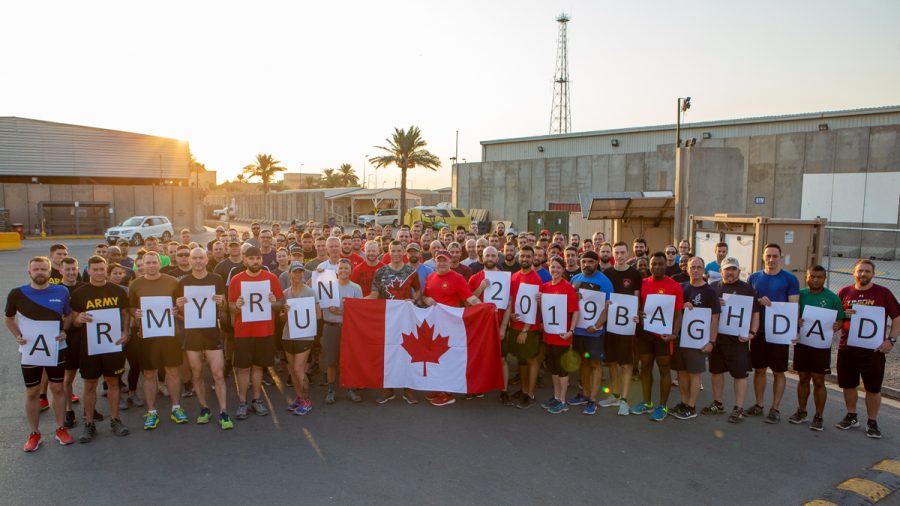
Peter Mallett, Staff Writer ~
A group of Canadian soldiers stationed at Union III military base in Baghdad have raised over $1,000 from a five-kilometre charity run for the non-profit Soldier On.
The 12 Canadian Armed Forces (CAF) personnel were part of a larger group of 110 runners from 15 coalition nations who work at the U.S. Army’s Combined Joint Operations Centre and took part in the Army Run. The fundraiser was organized by CAF members.
Operated by the Canadian Forces Transition Group, Soldier On provides year-round regional sports camps and activities for its participants and manages Canada’s Warrior Games and Invictus Games teams.
Petty Officer Second Class Kanwar Nijjer, a finance supervisor at CFB Esquimalt’s Naval Fleet School (Pacific), is currently deployed to Iraq and took part in the run.
“The run was also a great way to get to know other [military] members from around the world, and I made many friends that day,” said PO2 Nijjer. “Having a good physical training routine is a great way to relieve stress, take care of your body, and is ultimately tied to the success of the deployment.”
With average daytime high temperatures in the region reaching 40 Celsius, the run was held at 6:30 a.m. to avoid the scorching desert heat. Despite the early morning start time, PO2 Nijjer says the mercury climbed to 25 Celsius when the runners set off.
Run organizers raised a total $800 (U.S.) through sales of Army Run registration, and participants received a hat, race patch and dog tag as keepsakes.
PO2 Nijjer is part of Operation Impact, which was established in 2016 and is Canada’s contribution to the global coalition working to defeat Daesh (ISIS) in Iraq and Syria. The coalition’s efforts are primarily focused on providing training for domestic security forces. There are approximately 250 Canadian military personnel deployed in Iraq and include advisors, trainers, headquarters staff and force protection personnel.

Armoured- Registered User
- Posts : 396
Join date : 2018-01-31
 Re: Lookout
Re: Lookout
Veteran Service Card available to some
By Lookout on Oct 19, 2019
By Lookout on Oct 19, 2019

DND ~
The Veteran’s Service Card is now available upon request to all eligible former and releasing Canadian Armed Forces members. Veterans who have completed basic training and have been honourably released can now apply for the new Veteran’s Service Card at the following: https://bit.ly/2IEPpaL
The first stage of the Veteran’s Service Card was announced in September 2018. The Department of National Defence, Veterans Affairs Canada, and Library and Archives Canada are working together to ensure that the necessary resources are in place to verify, produce, and distribute the Veteran’s Service Cards in a timely manner.
“The women and men who have served in the Canadian Armed Forces deserve our full support as they transition to post-military life,” said Vice-Admiral Haydn Edmundson, Commander Military Personnel Command. “We introduced the Veteran’s Service Card in September of 2018, rolled out the stage two distribution last December and, as promised, the stage three distribution now begins. We have a sacred obligation to our women and men in uniform, and the Veteran’s Service Card acknowledges and recognizes their devoted service to Canada.”
In stage three, cards will be produced and issued upon request to all eligible Veterans who released prior to February 2016. Eligible Veterans in the stage two group—those who released between February 2016 and September 2018—who have not yet requested the card may also apply.
Moving forward, all Canadian Armed Forces members who are eligible receive the card automatically upon their release.
The Veteran’s Service Card provides a tangible symbol of recognition for former members, and encourages an enduring affiliation with the Canadian Armed Forces. It has no expiry date and it is not intended for use as an ID card, pursuant to Treasury Board of Canada Secretariat and other guidelines on official identification cards.
All serving Canadian Armed Forces members and Veterans are encouraged to register for a MY VAC Account: https://bit.ly/1opxr9L with Veterans Affairs Canada.
For more information on the Veteran’s Service Card, or to apply, visit www.canada.ca/veterans-service-card.

Ironman- Registered User
- Posts : 338
Join date : 2018-02-25
 Re: Lookout
Re: Lookout
Tackling veteran homelessness
By Lookout on Nov 24, 2019
By Lookout on Nov 24, 2019

During the 2019 National Defence Workplace Charitable Campaign, consider supporting charities that support homeless veterans.
Veterans’ homelessness is a growing issue in Canada. According to a 2014 report published in the Canadian Journal of Community Mental Health, there were 2,950 veterans staying in shelters, making up 2.2 per cent of annual shelter users.
The report also highlighted how approximately 25 per cent of the veteran population in Canada face difficulties transitioning from military service to civilian life, and have an increased risk of homelessness, mental illness, and addictions.
While veterans make up approximately two per cent of the Canadian population, advocates are concerned with the overrepresentation of veterans in the homeless population.
Factors at play
No one organization or group or level of government can hope to tackle veterans’ homelessness on their own. There are a multitude of factors that contribute to, and perpetuate this issue.
The study noted that veterans comprised 4.3 per cent of a sample of the adult homeless population with severe mental illness.
Veterans identified additional transition challenges beyond starting a new career. One veteran described the transition “like being on Mars and coming back to earth”.
Veterans can be hesitant to ask for help, not feeling worthy of the supports made available to them or being distrustful of those offering help.
VAC questionnaires and application forms can seem daunting and complex.
The study showed a higher incidence of addiction and mental illness among veterans, but especially for those experiencing homelessness. While 11 per cent of veterans suffer from post-traumatic stress disorder (PTSD), many reported using alcohol to deal with their mental health, and some started using while in the military.
Some of the problems that put veterans at risk of homelessness were not present when they began their military services, but instead developed over time.
To be effective, peer-support requires knowledge of the military service and homelessness-related issues.
Government Initiatives
The Government of Canada’s Homelessness Partnering Strategy provided over $700 million over five years (2014-2019) to prevent and reduce homelessness in Canada. One of strategy’s directives for this period is veteran homelessness, and the government’s Homelessness Partnering Strategy and Veterans Affairs Canada are working together to coordinate the regional and community-level services delivered by both departments. The strategy also worked with emergency shelters and crisis service providers in an effort to identity homeless veterans and those at imminent risk in order to connect them with veteran-specific services.
The State of Homelessness in Canada 2016 called for a Housing First strategy focused on reducing emergency shelter use among veterans, urging the federal government to provide:
Funding for veterans who are at risk of, or who are experiencing homelessness.
New affordable housing units designed to support veterans and their needs.
Expanded eligibility of veteran benefits beyond those who can demonstrate a direct link between military service and their injury or illness, including greater flexibility for local offices to distribute emergency funds.
Lastly, the Government of Canada released the results of the Let’s Talk Housing consultations. Being part of the development of the country’s first National Housing Strategy is a critical step to ensure that it addresses the housing needs of veterans.
Support from the Defence Team
The National Defence Workplace Charitable Campaign (NDWCC) strives to make a difference in the lives of those in need. In 2018, this translated into roughly $3,500,000 in donated funds. These funds aided those impacted by local tornadoes and floods, and supported military-related charities, as well as a multitude of other worthy causes.
Our NDWCC campaign provides Defence Team members with a direct line to donate to over 86,500 charities, including numerous organizations with strong ties to Canada’s military. There are also charities that support homeless veterans.
Support these charities in their work to tackle the growing issue of veterans’ homelessness, to understand why it happens, how to prevent it, and how to ensure support is available and suits the needs of former CAF members.
Become a part of the solution.

Thunder- Registered User
- Posts : 319
Join date : 2018-10-31
 Re: Lookout
Re: Lookout
Wounded veteran finds comfort with Sacrifice Medal
By Lookout on Dec 04, 2019

Peter Mallett, Staff Writer ~
A retired career soldier with family ties to CFB Esquimalt says the recent awarding of a Sacrifice Medal has been the perfect tonic to accelerate his recovery from deployment injuries, mental and physical.
Chief Warrant Officer (Retired) Brad Amirault received the medal from General Jonathan Vance, Chief of the Defence Staff, in a formal ceremony at Juno Tower at CFB Halifax on Nov. 23.
The Sacrifice Medal was established in 2008 as a replacement to the Wound Stripe medal and is part of a continued effort by the Government of Canada to provide formal recognition to those who die as a result of military service or are wounded in action.
CWO Amirault says having the medal presented by his friend and former Commanding Officer Gen Vance was an emotional and heartfelt moment.
The two men shared a hearty handshake in the hallway prior to the ceremony and even some tears during the proceedings as they recounted some shared, difficult times where they drew strength from each other as warriors do.
“Having the senior Canadian Forces commander present the medal in front of my immediate family members was an honour that I will proudly wear for the rest of my days.”
Adding to the emotions, says CWO Amirault, was the outpouring of support from dozens of family members and friends at a reception held the next day.
“It was huge to have all these people supporting me and to see a video presentation of my career played during the ceremony. I truly believe the moment helped me effectively communicate to my family what I could not verbalize. I was reminded of my roots and how important it is to have family.”
CWO Amirault had a 34-year career in the Canadian Armed Forces until injuries sustained during training, and on his operational tours in Bosnia, Haiti, Afghanistan led to his transition out of the military in 2018.
Today, he suffers from persistent pain in the lower back, neck, hip and ankles, Post-Traumatic Stress Disorder (PTSD), anxiety, and depression.
While in Bosnia, he witnessed the atrocities of war that still haunt him to this day. His injuries, both mental and physical, continued to accumulate during his career as an infantry soldier serving in the Oka crisis of 1990, Bosnia in 1992-93, and 1996, the Middle East in 2003, Haiti in 2004, and Afghanistan in 2010.
He says recovery from his trauma-related injuries took a giant leap forward when he was presented the medal. His daughter, Leading Seaman Lily Amirault of Naval Fleet School Pacific helped organize the ceremony and the informal reception the following day at a nearby hotel. LS Amirault was also instrumental in putting out the successful request for Gen Vance to present the medal.
“I think my father is one of the most deserving people for this medal and I was so happy to see him overcome with emotion and tears of happiness when he received it from Gen Vance,” said LS Amirault. “But it was also a bitter-sweet moment because when I looked at all the images of my father from 10 or 20 years ago during the event’s video presentation, and the toll his injuries have taken on him, the moment was also very painful for myself and the family as a whole.”
Other family members attending the ceremony with military ties included his cousin Colonel John MacDonald, 36 Canadian Brigade Group Commander, and his son Corporal Nicholas Amirault, a member of 33 Signal Regiment of the Royal Canadian Corps of Signals in Ottawa, Ontario.
By Lookout on Dec 04, 2019

Peter Mallett, Staff Writer ~
A retired career soldier with family ties to CFB Esquimalt says the recent awarding of a Sacrifice Medal has been the perfect tonic to accelerate his recovery from deployment injuries, mental and physical.
Chief Warrant Officer (Retired) Brad Amirault received the medal from General Jonathan Vance, Chief of the Defence Staff, in a formal ceremony at Juno Tower at CFB Halifax on Nov. 23.
The Sacrifice Medal was established in 2008 as a replacement to the Wound Stripe medal and is part of a continued effort by the Government of Canada to provide formal recognition to those who die as a result of military service or are wounded in action.
CWO Amirault says having the medal presented by his friend and former Commanding Officer Gen Vance was an emotional and heartfelt moment.
The two men shared a hearty handshake in the hallway prior to the ceremony and even some tears during the proceedings as they recounted some shared, difficult times where they drew strength from each other as warriors do.
“Having the senior Canadian Forces commander present the medal in front of my immediate family members was an honour that I will proudly wear for the rest of my days.”
Adding to the emotions, says CWO Amirault, was the outpouring of support from dozens of family members and friends at a reception held the next day.
“It was huge to have all these people supporting me and to see a video presentation of my career played during the ceremony. I truly believe the moment helped me effectively communicate to my family what I could not verbalize. I was reminded of my roots and how important it is to have family.”
CWO Amirault had a 34-year career in the Canadian Armed Forces until injuries sustained during training, and on his operational tours in Bosnia, Haiti, Afghanistan led to his transition out of the military in 2018.
Today, he suffers from persistent pain in the lower back, neck, hip and ankles, Post-Traumatic Stress Disorder (PTSD), anxiety, and depression.
While in Bosnia, he witnessed the atrocities of war that still haunt him to this day. His injuries, both mental and physical, continued to accumulate during his career as an infantry soldier serving in the Oka crisis of 1990, Bosnia in 1992-93, and 1996, the Middle East in 2003, Haiti in 2004, and Afghanistan in 2010.
He says recovery from his trauma-related injuries took a giant leap forward when he was presented the medal. His daughter, Leading Seaman Lily Amirault of Naval Fleet School Pacific helped organize the ceremony and the informal reception the following day at a nearby hotel. LS Amirault was also instrumental in putting out the successful request for Gen Vance to present the medal.
“I think my father is one of the most deserving people for this medal and I was so happy to see him overcome with emotion and tears of happiness when he received it from Gen Vance,” said LS Amirault. “But it was also a bitter-sweet moment because when I looked at all the images of my father from 10 or 20 years ago during the event’s video presentation, and the toll his injuries have taken on him, the moment was also very painful for myself and the family as a whole.”
Other family members attending the ceremony with military ties included his cousin Colonel John MacDonald, 36 Canadian Brigade Group Commander, and his son Corporal Nicholas Amirault, a member of 33 Signal Regiment of the Royal Canadian Corps of Signals in Ottawa, Ontario.

Stanleyz- Registered User
- Posts : 333
Join date : 2018-02-04
 Re: Lookout
Re: Lookout
Honouring the Gulf War
By Lookout on Dec 06, 2019
By Lookout on Dec 06, 2019
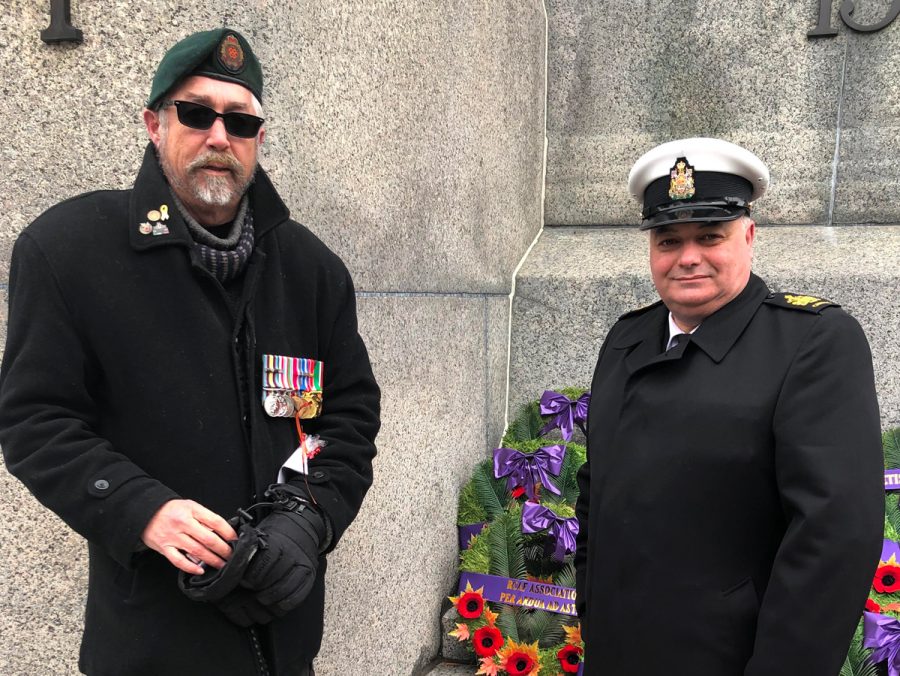
Peter Mallett, Staff Writer ~
It was only a short moment in time when Chief Petty Officer First Class Gerald Doutre carried a wreath up the steps to the National War Memorial and gently laid it at the base of the massive stone sculpture.
Etched on the ribbon adorning the Remembrance Day wreath were the words Persian Gulf Veterans of Canada. To those watching, it was just another wreath joining the dozens carefully placed there during the Nov. 11 service. But to hundreds of military members like CPO1 Doutre, it was a marker of time served in a long-ago war.
“It was certainly a proud moment for all Persian Gulf veterans and me, and without a doubt it was also therapeutic,” said CPO1 Doutre. “We had a lot of good folks over there who sacrificed so much; attending this ceremony gave us a chance to remember this and create awareness for the rest of Canada about what we did in the gulf war.”
Today, CPO1 Doutre, 50, works as Division Chief for the Director General of Maritime Equipment and Program Management in Gatineau, Que. He is also a member of the Persian Gulf Veterans of Canada.
Almost three decades ago, as a young Leading Seaman, he deployed to the Persian Gulf as a Naval Electronic Sensor Operator on board HMCS Athabaskan. The Iroquois-class destroyer was the command and control vessel for the three-ship Canadian Task Group, with their efforts largely focussed on resupplying Allied ships fighting in the war.
He vividly remembers the black, acrid smoke clouding the sky over Kuwait from oil wells set on fire by Iraqi troops, and when Athabaskan was called on to escort guided missile cruiser USS Princeton and USN tugboat after Princeton was severely damaged on Feb. 18, 1991, by two bottom-mounted influence mines.
“As far as facing danger during operational deployment, it was definitely up there because we didn’t really know what to expect and had to negotiate through an area of underwater mines when we were escorting,” said CPO1 Doutre. “The interesting thing about the gulf war was even though the war itself lasted just 49 days, we were stationed there for much longer and didn’t know when we would be coming back home.”
The Persian Gulf Veterans of Canada is an advocacy, social and support association for Persian Gulf Veterans and their families. They work to increase awareness of Canada’s contributions in the Persian Gulf War to the Canadian public. For more information on membership and ways to support their efforts visit their website at http://persiangulfveteranscanada.ca
Persian Gulf War Facts
The Canadian Naval Task Group, consisting of the destroyers HMCS Terra Nova and HMCS Athabaskan, and the supply ship HMCS Protecteur, helped support coalition fleet efforts in the region. Five Sea King helicopters from 443 MH Squadron were also part of this force.
CF-18 jet squadrons with approximately 500 personnel operated out of the “Canada Dry” bases in the Persian Gulf nation of Qatar, performing combat air control, escort, and reconnaissance missions. For the first time since the Korean War, Canadian air-to-surface attacks took place during the conflict.
The Canadian Air Command’s Transport Group carried personnel and cargo in the region. A Canadian plane was used in aerial refueling duties for coalition air forces.
A Canadian field hospital with 530 personnel was established in Al-Qaysumah, Saudi Arabia, in February 1991. This hospital cared for both coalition and Iraqi wounded.
Soldiers from units such as the Royal Canadian Regiment and the Royal 22e Régiment performed security duties at Canadian installations in the Middle East in 1990-1991.
The Gulf War marked the first time that female Canadian Armed Forces members performed combat duties.

Lonestar- Registered User
- Posts : 243
Join date : 2017-10-14
 Re: Lookout
Re: Lookout
Canadian researcher investigates gender and peacekeeping
By Lookout on Dec 11, 2019
By Lookout on Dec 11, 2019
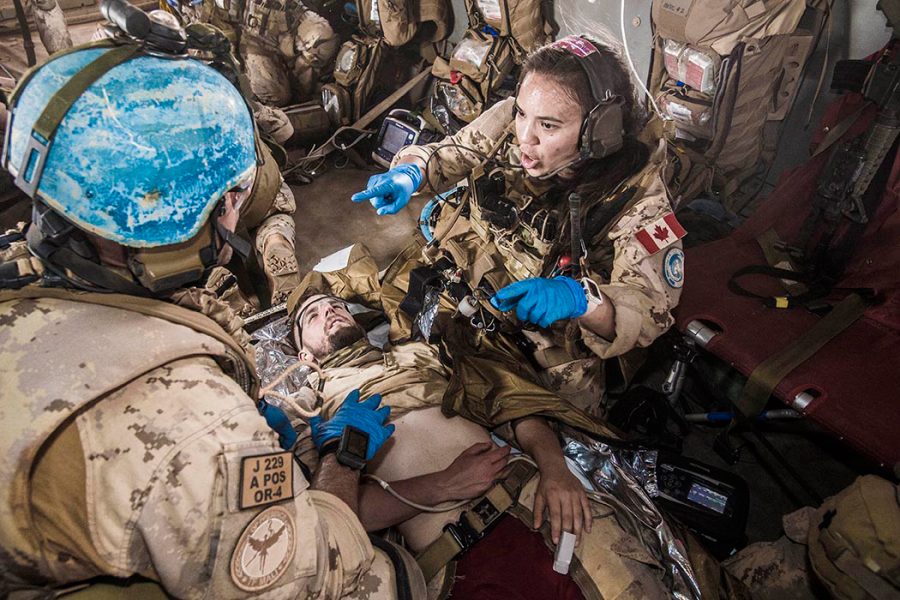
A female member of Task Force-Mali’s Canadian Medical Emergency Response Team provides direction during a forward aeromedical evacuation exercise aboard a CH-147F Chinook helicopter in March. Photo by Corporal François Charest, 430 Tactical Helicopter Squadron (430 Tac Hel Sqn)
Steven Fouchard, Army Public Affairs ~
As the United Nations and militaries across the world work toward greater female representation in peacekeeping operations, a Canadian researcher is delving into this little-studied area to shed more light on the potential implications.
Andrea Lane, a PhD candidate at Dalhousie University, is on a year-long contract at the Canadian Forces College where she has been invited to teach as part of its National Security and Joint Command and Staff programmes.
As Director of Dalhousie’s Centre for the Study of Security and Development, she notes she has long-standing research interests in Canadian defence policy and in particular women in the military.
As she began research relating to Canada’s part in the UN mission in Mali – where Canadian operations ceased on Aug. 31, 2019 – the federal government rolled out a pilot project in 2017 known as the Elsie Initiative for Women in Peace Operations, which seeks to increase women’s meaningful participation in peace operations.
While she is generally supportive of efforts to make male-dominated militaries more open to women, Lane said current thinking on women’s roles in peacekeeping may not be entirely beneficial.
“There are a whole bunch of assumptions that are largely untested about women as better communicators, as people who are more likely to tone down conflict versus add to conflict – women being seen as warmer and more approachable by civilians,” she explained. “So it sets a different burden on women peacekeepers that is really about singling them out as different than the norm for peacekeeping, which is male.”
“On the surface, getting more women into peacekeeping is clearly a win for women,” she adds. “How can you argue that’s bad? It’s when you start looking at the reasons behind that inclusion you realize that actually there are effects that may make it more difficult for their complete integration. It’s not fully integrating them within the military and saying, ‘We want women soldiers because of everything they bring to the table.’”
The UN recently took the step of directing member nations to form peacekeeping engagement teams – soldiers responsible for outreach to civilian populations – with a minimum of 50 per cent female representation. The body of research into the effects of such initiatives on those they are designed to help, Lane noted, is small.
“Some evidence from the deployment of female engagement teams in Nordic militaries – Sweden, Denmark – in Afghanistan found that the women who were involved were viewed by their male colleagues as women first and soldiers second and that they needed to be protected. But that was a small study. Rigorous evidence for some of these claims about female peacekeepers is really lacking and there’s no Canadian evidence, so actually adding to the body of evidence is one of the main reasons I’m doing the research.”
The contract with Canadian Forces College is not related to her research but is a “happy coincidence,” given that it will provide access to female military officers for interviews that will inform her dissertation.
At the time of writing, Lane was still waiting a go-ahead from the College and Dalhousie before she could begin interviews. However, some media coverage is already attracting attention.
Word of mouth is also playing a part, and she is finding other potential subjects through her own personal networks and those of her spouse, a Royal Canadian Navy officer.
“What I have found, and I’m very grateful for this, is that women are interested in talking about this because of the way that it affects their professional lives.”

Tazzer- Registered User
- Posts : 284
Join date : 2018-05-26
 Re: Lookout
Re: Lookout
Changes announced to Service Medals
By Lookout on Jan 13, 2020

As part of Strong, Secure, Engaged, (SSE 7), the Government of Canada is modernizing the Canadian Armed Forces Honours and Awards system to ensure military members’ service to Canada is recognized in a timelier and appropriate manner.
This initiative encompasses the modernization of the overseas service recognition framework. The objective is to make service medals more accessible and flexible to ensure that Canadian Armed Forces (CAF) members receive appropriate recognition for their participation in, and direct support to, operations.
As part of this initiative, changes to the eligibility list for the Special Service Medal with NATO bar, and a reduction of the time criteria to 45 days for both the NATO and Expedition bars to that same medal, were announced on Feb. 18, 2018, in CANFORGEN 001/20.
The government has now recently approved a number of additional measures to meet the stated intent. The time criteria for the General Campaign Star (GCS), General Service Medal (GSM) and Operational Service Medal (OSM) have been reduced to ensure recognition remains attainable to participants in light of new deployment patterns where CAF members more often deploy for short periods of time.
Each ribbon for those medals has a new time criteria beginning with an appropriate recent (post-Afghanistan) operational date as per the table to the right. There are transition measures that ensure anyone who serves at least one eligible day after the stated date is allowed to cumulate any previously accrued time towards the new criteria for the medal.
The criteria for the rotation bars will not be affected by these changes meaning that the first bar will continue to be awarded after a total of 210 eligible days while subsequent bars are awarded for every period of 180 eligible days thereafter.
The Special Service Medal, which had up to now been reserved for CAF members, has been amended to expand eligibility to Canadian civilians and members of allied forces working for the CAF from April 29, 2014. The intention is to align this medal with other modern service medals that allow recognition of all members of the Defence Team who play a key role in the success of our operations.
The limitations for visits in theatre have been reduced. As a result, technical assistance visits, staff inspection visits, staff assistance visits and specialists visits in theatre will now be credited towards the appropriate service medal. Visits for the purpose of command, familiarization, leadership and morale remain excluded from eligibility.
These changes will ensure that recognition is keeping pace with the evolving nature of current and future CAF operations and remains a worthy and attainable reward for personnel while preserving the symbolic value and respect for the service medals in question.
Please refer to CANFORGEN 001/20 or to the Canadian Medals Chart for more information:
www.canada.ca/en/department-national-defence/services/medals/medals-chart-index.html

By Lookout on Jan 13, 2020

As part of Strong, Secure, Engaged, (SSE 7), the Government of Canada is modernizing the Canadian Armed Forces Honours and Awards system to ensure military members’ service to Canada is recognized in a timelier and appropriate manner.
This initiative encompasses the modernization of the overseas service recognition framework. The objective is to make service medals more accessible and flexible to ensure that Canadian Armed Forces (CAF) members receive appropriate recognition for their participation in, and direct support to, operations.
As part of this initiative, changes to the eligibility list for the Special Service Medal with NATO bar, and a reduction of the time criteria to 45 days for both the NATO and Expedition bars to that same medal, were announced on Feb. 18, 2018, in CANFORGEN 001/20.
The government has now recently approved a number of additional measures to meet the stated intent. The time criteria for the General Campaign Star (GCS), General Service Medal (GSM) and Operational Service Medal (OSM) have been reduced to ensure recognition remains attainable to participants in light of new deployment patterns where CAF members more often deploy for short periods of time.
Each ribbon for those medals has a new time criteria beginning with an appropriate recent (post-Afghanistan) operational date as per the table to the right. There are transition measures that ensure anyone who serves at least one eligible day after the stated date is allowed to cumulate any previously accrued time towards the new criteria for the medal.
The criteria for the rotation bars will not be affected by these changes meaning that the first bar will continue to be awarded after a total of 210 eligible days while subsequent bars are awarded for every period of 180 eligible days thereafter.
The Special Service Medal, which had up to now been reserved for CAF members, has been amended to expand eligibility to Canadian civilians and members of allied forces working for the CAF from April 29, 2014. The intention is to align this medal with other modern service medals that allow recognition of all members of the Defence Team who play a key role in the success of our operations.
The limitations for visits in theatre have been reduced. As a result, technical assistance visits, staff inspection visits, staff assistance visits and specialists visits in theatre will now be credited towards the appropriate service medal. Visits for the purpose of command, familiarization, leadership and morale remain excluded from eligibility.
These changes will ensure that recognition is keeping pace with the evolving nature of current and future CAF operations and remains a worthy and attainable reward for personnel while preserving the symbolic value and respect for the service medals in question.
Please refer to CANFORGEN 001/20 or to the Canadian Medals Chart for more information:
www.canada.ca/en/department-national-defence/services/medals/medals-chart-index.html


RevForce- Registered User
- Posts : 245
Join date : 2018-08-29
Page 3 of 23 •  1, 2, 3, 4 ... 13 ... 23
1, 2, 3, 4 ... 13 ... 23 
Page 3 of 23
Permissions in this forum:
You cannot reply to topics in this forum|
|
|

 Home
Home
